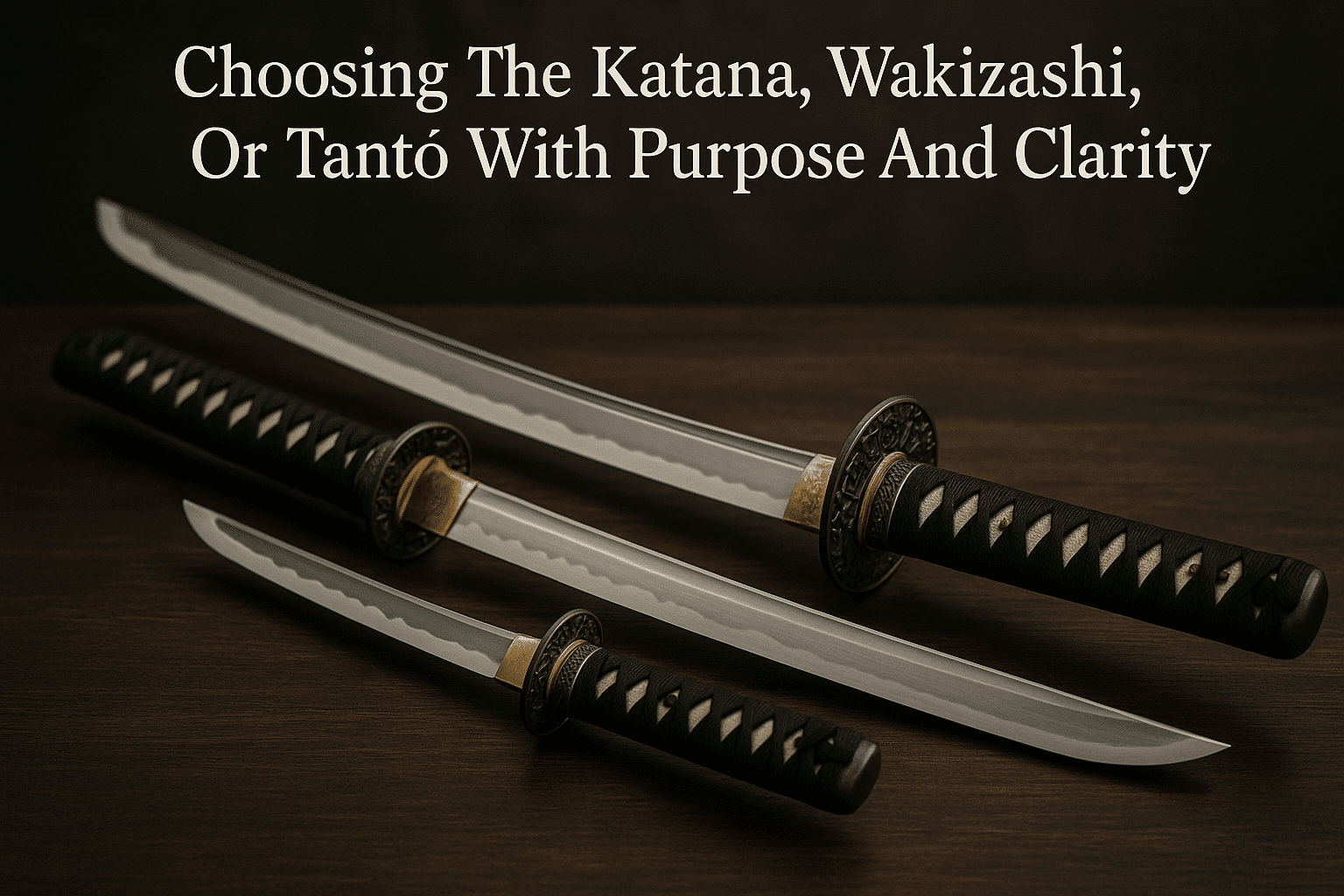Introduction: The Way of the Sword
The Japanese sword is more than a weapon. It is a reflection of precision, discipline, and purpose. When choosing a sword—whether for display or for Iaido practice—one steps into a tradition shaped by centuries of craftsmanship and philosophy.
This decision is not made lightly. A sword for the wall honors beauty, history, and form. A sword for Iaido must balance weight, feel, and movement. Both choices demand respect for the art behind the blade.
A true sword is not just seen—it is understood.
In the following sections, we will explore how to choose boldly yet mindfully. Whether your path leads to practice or appreciation, the sword welcomes only those who approach with focus and care.
The Katana: Balance and Legacy
The katana is the soul of the samurai. Forged with balance and intention, it reflects centuries of discipline.
Its history begins in feudal Japan, developed as a response to changing warfare. Warriors needed a sword that was swift, strong, and precise. The katana met that need.
Each blade measures around 60 to 80 centimeters. It has a single edge and a gentle curve. The design allows for smooth, powerful cuts, drawn in a single motion. It is light enough to carry, yet crafted to endure.
More than a weapon, the katana is a symbol. It represents honor, mastery, and a timeless code. Swordsmiths poured spirit into steel. Their work was respected as art—as legacy.
Today, the katana endures not by use, but by meaning. It hangs in dojos and collections. It teaches patience, respect, and restraint.
The katana is not just remembered. It is revered.
The Wakizashi: Companion in the Shadows
Shorter than the katana, the wakizashi was the samurai’s steadfast companion. Typically between 12 and 24 inches in length, it was worn at the waist, paired with the katana in a daishō—the “big-little” set.
The wakizashi served many roles. Indoors, it was the weapon of choice, where the katana’s length was impractical. In combat, it acted as a backup, drawn when the primary sword was lost or broken. In ritual, it bore quiet gravity, used in acts such as seppuku.
Symbolically, the wakizashi reflected the inner life of the samurai. Unlike the katana, which met the outside world, the wakizashi stayed close, even during sleep. Its presence was constant, a reminder of resolve and readiness.
Though smaller, it held no less purpose. The wakizashi was not a lesser blade—it was simply a different one. Quiet, precise, and ever near, it shadowed the soul of the warrior.
The Tantō: Precision and Intention
The tantō is a short blade with a sharp purpose. Typically under 12 inches, it was crafted for one-handed use in close quarters. Warriors carried it as a sidearm, ready when the sword was not.
Its form is simple—straight or slightly curved, with a single edge and thick spine. This design makes the tantō strong enough to pierce armor and precise enough for exact cuts.
In the hands of a samurai, it was not only a weapon but a statement of readiness. In moments too tight for larger swords, the tantō answered without hesitation.
Collectors value the tantō for its balanced beauty—form unified with function. Martial artists respect its demand for control and clarity in movement.
Every line and edge carries intention. The tantō is not showy. It doesn’t need to be.
Choosing for Display: Symbolism, Size, and Aesthetics
When selecting a blade for display, approach it with purpose. Let the sword speak through its form, balance, and meaning.
Choose a blade that carries symbolism. A katana may reflect honor and discipline. A wakizashi, loyalty and inner strength. Match the blade to the message you wish to convey.
Size matters. A full-length katana commands presence but requires space and clean lines. Shorter blades offer subtlety and quiet authority. Let the proportions suit the setting.
Aesthetics complete the piece. Look for clean curvature, refined fittings, and a harmonious scabbard. Avoid excess. Let craftsmanship and restraint define the display.
A blade on display is not just decoration—it’s a moment of history, still and deliberate. Place it where it can breathe. Let it remind you of stillness, focus, and the path.
Choosing for Practice: Iaido Fundamentals
In Iaido, your sword is your partner. Choosing it with care sets the tone for your entire practice.
Start with weight and balance. A well-balanced sword feels like an extension of your body. It should neither pull you forward nor resist your movements. Hold it lightly. Draw it slowly. If it feels centered, it likely is.
Blade length matters. Too long, and it’s hard to draw cleanly. Too short, and your reach is limited. Stand straight. Rest the blade’s tip just an inch off the ground. That’s usually right.
Beginners practice with an iaitō—an unsharpened metal sword made for training. Aluminum versions are lighter; zinc-aluminum alloys offer better balance. Save a shinken—a live, sharpened blade—for advanced practice and demonstrations.
Grip shape counts. Oval handles fit the hand naturally. Round ones turn more easily. Choose what gives you control.
In time, you will know what feels right. Until then, choose with patience. Train with intent. Let the sword teach you.
Conclusion: Mindful Selection
Choosing a blade is choosing a path. Each type—katana, tanto, wakizashi—holds its own purpose. Form, balance, and edge reflect the traditions they come from.
Understanding these traits is not just technical—it is mindful. The right blade suits the hand, the art, and the spirit of the user. Whether displayed with reverence or drawn in practice, it should speak of clarity and intention.
Weapons are tools. Tools shape movement. Movement reflects thought. So choose with care. Honor the path. Let every cut begin with stillness.





